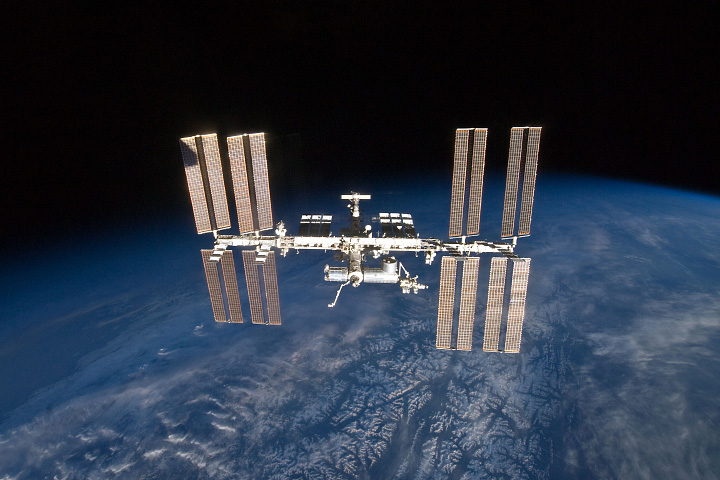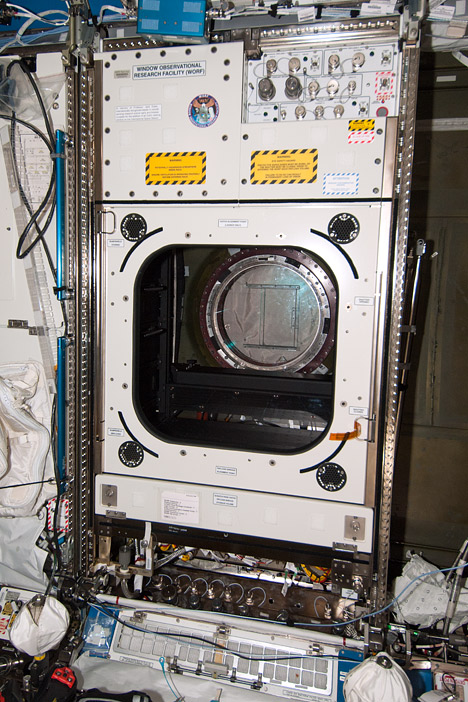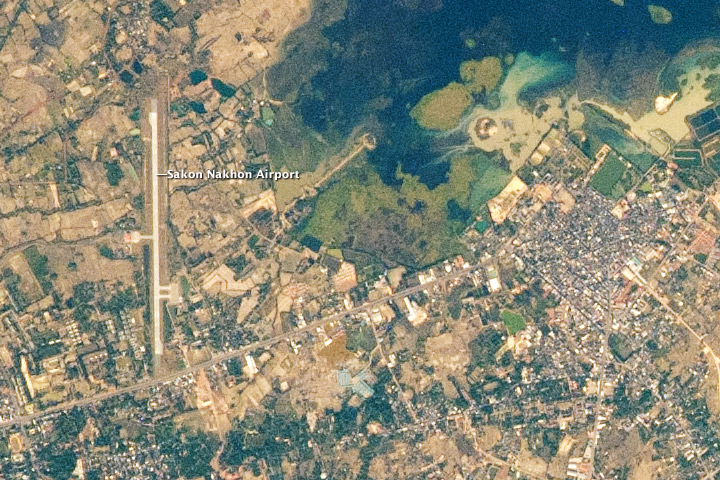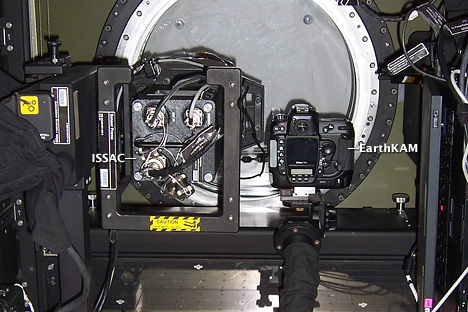

Like a human who just went through laser vision correction, the International Space Station (ISS) recently got a clearer view of our world. That improved view is opening up new vistas for students in American classrooms.
The Window Observational Research Facility (WORF) was delivered to the ISS in April 2010 on the STS-131 mission of Space Shuttle Discovery. It was installed and prepped on the Destiny Laboratory over the past year, and includes the highest quality optics ever flown on a human-occupied spacecraft.


The International Space Station (top) and the Destiny Laboratory (lower). (Astronaut photograph S131-E-011050, taken on April 17, 2010. Astronaut photograph S130-E-012258, taken on February 20, 2010.)
The arrival of the WORF has allowed astronauts to permanently remove a protective, non-optical “scratch pane” on the window, which had often blurred images. The WORF also provides a highly stable mounting platform to hold cameras and sensors steady, while offering power, command, data, and cooling connections. With the WORF, the high-quality optics of the nadir viewing window—looking “straight down” towards the Earth—are now fully utilized for the first time since Destiny was launched in 2001.
“Optically speaking, the scratch panes limited the resolution that could be obtained with spectral imagers or cameras,” said former astronaut Mario Runco, who was part of the design and development teams for the WORF, and now serves as the lead for spacecraft window optics and window utilization at NASA’s Johnson Space Center. “With the WORF finally in place, we can now make full use of the investment in an optical quality window for Earth science and observation.”

The Window Operational Research Facility provides a stable mounting platform to hold cameras and sensors, while offering power and data connections. (Astronaut photograph S131-E-008619, taken on April 10, 2010.)
The subject of the first test image from the WORF was British Columbia’s snow-capped mountains and coastline in western Canada. The image, captured with a 50 millimeter lens on January 17, 2011, features an area just north of Vancouver Island, centered at 51.8 degrees north latitude and 127.9 degrees west longitude, and covering an area approximately 200 kilometers (124 miles) by 134 kilometers (83 miles). Calvert Island is visible at image left, and the glaciers of the Heiltskuk Ice Field in the Coast Mountains are visible at image right. In between the two are Oweekeno Lake and inlet.

The first EarthKAM image from WORF: the Coast Mountains of British Columbia. (EarthKAM image 9362, Taken on January 17, 2011.)
While it’s not a particularly unique image, it is notable for the clarity and sharpness of ground features even though it was taken with a wide-angle lens. It is a significant improvement from similar imagery acquired through the Destiny lab window when the non-optical quality pane was in place.
The image was taken to test the control computer and camera associated with the EarthKAM payload, an educational outreach project that allows middle school students to remotely take pictures of their home planet from the unique perspective of the space station, 220 miles above the Earth’s surface.
“We are very excited to have a new camera system that appears to be functional and taking incredible images,” said Karen Flammer, who manages EarthKAM operations at the University of California, San Diego.
Following the British Columbia test images, the first student images were taken by Parkview Montessori in Jackson-Madison County, Tennessee, and by Public School 229–Dyker in Brooklyn, New York. Teacher Vickie LeCroy’s students at Parkview plan to study landforms such as islands, mountains, and deserts in the EarthKAM image they obtained of Mexico. Dyker teacher Camille Fratantoni and her students plan to enrich their studies of Earth Science and learn more about NASA missions.
After the first two days, EarthKAM ground controllers worked with Expedition 26 astronaut Cady Coleman to swap from a 50 millimeter (f1.4) lens to a 180 mm (f2.8) lens, in order to capture images with finer detail. Soon students from 146 participating schools captured 1,023 more images (1,562 total).
“The clarity and level of detail is captivating,” said Brion Au, EarthKAM payload developer. “Never before in the history of EarthKAM have images of this quality been possible.”


Photograph and zoomed enlargement of That Choeng Shum, Thailand. (EarthKAM Winter 2011 Mission Image 59371.)
An image of That Choeng Shum, Thailand—taken on January 21, 2011—demonstrates the clarity of images taken through the Destiny lab window and WORF. The view is so crisp that details such as the stripes (about 6 meters wide) on the Sakon Hakhon runway are faintly visible.
The new combination of the Destiny lab window and the WORF adds to the space station’s capabilities as a remote-sensing platform for Earth science. It enables the operation of high-resolution cameras and multi- or hyperspectral imagers within the pressurized environment of the ISS. And the WORF/Optical Window tandem also can be used for research and applications in fields such as geology, volcanology, meteorology, oceanography, coastal ocean management, ranch and forestry management, and disaster assessments and management.
In this capacity, the ISS can be used not only as a test bed for new instruments, but as an operating location for current sensor technology without the space environment and platform design requirements necessary for “free-flyer” orbital sensors.

In a mockup (testbed) version of the WORF and Destiny Laboratory window at NASA Johnson Space Center, the ISSAC (left) and EarthKAM (right) are installed on the stable payload shelf. (NASA photograph courtesy Johnson Space Center.)
Currently, both the EarthKAM and the ISS Agricultural Camera (ISSAC) are onboard the ISS. EarthKAM is operational now, while ISSAC will become operational in the spring of 2011, when both payloads will conduct simultaneous but independent operations—the first time multiple payloads would be operational in the WORF for Earth science.
ISS EarthKAM photograph Winter 2011 Mission Image 9362 was acquired on January 17, 2011, with a Nikon D2Xs digital camera fitted with a 50 mm lens. ISS EarthKAM photograph Winter 2011 Mission Image 59371 was acquired on January 21, 2011, with a Nikon D2Xs digital camera fitted with a 180 mm lens. Both images are provided by the ISS Crew Earth Observations experiment and the Image Science & Analysis Laboratory, Johnson Space Center. The EarthKAM payload was set up by Expedition 26 crew member Cady Coleman. EarthKAM ground controllers took both images. The images in this article have been cropped and enhanced to improve contrast. The International Space Station Program provides integration for payloads such as EarthKAM as part of the ISS National Lab. Also, images taken by astronauts and cosmonauts can be viewed at the NASA/JSC Gateway to Astronaut Photography of Earth.